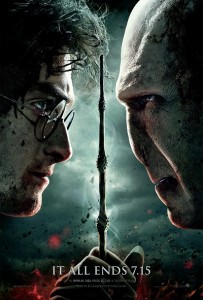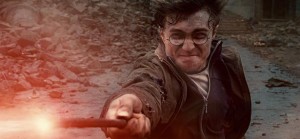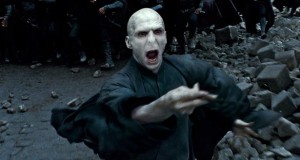 Renn’s review of Deathly Hallows, Part I.
Renn’s review of Deathly Hallows, Part I.
—-
Here we are at the end of all things, and the only question one can ask is: “Did they pull it off?”
If what you’re looking for from the second half of the final Harry Potter film is a satisfying visualization of the tragedy and triumph woven throughout the conclusive chapter of the long running series, then you’ll find that they did indeed pull it off. Spectacularly. If you’re looking for a delicate acknowledgement and exploration of the various thematic and subtextual layers present in the source material and the best of the films, then you’ll find that they pulled that off too. Competently. Finally, if you’re looking for a conclusion to a two-part film experience that forms a cinematically satisfying, unified whole… well, that gets a bit more complicated.
Deathly Hallows Part 2 wastes no time on regarding the uninitiated, and picks up from the last film with the overlap of a mere single scene. Our heroes have lost more friends and are still after the slivers of Voldemort’s soul that, if destroyed, will allow them to finally kill the most powerful evil wizard of all time. A few shorts sequences later and Harry and company return to Hogwarts as Voldemort attacks the castle with all of his considerable might. A massive, deadly wizarding battle becomes the backdrop for the vast majority of the film, as Harry Potter attempts to save the wizarding world he has come to love, even as it is literally torn down around him by the foundations. All of this is rendered beautifully, sometimes painfully, and the character beats that truly matter are all given their due. There are minor weak spots and places were the shorthand may not go quite far enough to satisfy all, but as in the first half of Deathly Hallows, director David Yates and screenwriter Steve Kloves leverage every possible frame of banked imagery and visual shorthand to nail the details with subtle strokes.
In terms of story Deathly Hallows stages the most sophisticated fantasy battle since those in The Lord of the Rings, and then plays its large plot stroke strokes against it. Once the war begins raging at Hogwarts, there is the sense of death and conflict at every moment, even when the focus tightens on Harry and his attempts to track down the final lost Horcrux and face off with Voldemort. This entire extended sequence serves as its own massive ticking clock, and every duel, every search, every conversation is a small, stressed pause amidst apocalyptic urgency. This isn’t a children’s fantasy, Narnia-version of war either– this is blood-soaked, rubble-flying, and smoke-clouded duels with mortars and bullets exchanged with colorful spells of equally concussive power. In some places stone automatons defend the castle against massive trolls, with the resulting rubble standing in for what would be hideous gore. The action never holds on these sequences for extended periods of time as there is too much our heroes are trying to accomplish, but the scenes sneak in between sequences or in the background persistently for an extraordinarily length of time. This is a true magical war film.
 There are certainly calms before and during the storm, and in them there are wonderful moments such as McGonagall reassuming control of the student body and preparing the castle for battle, or the scenes in which Voldemort’s cold voice filters into every wizard’s head with threats and ultimatums. It is in these moments that you see Harry’s struggle is affecting hundreds, and that characters we know and love are dying for him. This then puts the viewer in a place to feel the crushing guilt that infects Harry’s soul as everything comes down to him and his actions. Fortunately Daniel Radcliffe has found the effortless center of a character he has grown up playing, and he handles every moment of fear, doubt, courage, and triumph with the kind of performance that will make you cry and shout, even when you know what comes next. The same is true of Watson and Grint, who take more of a backseat than some might like in the film, but have such an irreplaceable chemistry with each other and with Radcliffe that they shine out whenever they’re on screen, and don’t feel far away when the story must narrow itself to Harry’s lonely journey.
There are certainly calms before and during the storm, and in them there are wonderful moments such as McGonagall reassuming control of the student body and preparing the castle for battle, or the scenes in which Voldemort’s cold voice filters into every wizard’s head with threats and ultimatums. It is in these moments that you see Harry’s struggle is affecting hundreds, and that characters we know and love are dying for him. This then puts the viewer in a place to feel the crushing guilt that infects Harry’s soul as everything comes down to him and his actions. Fortunately Daniel Radcliffe has found the effortless center of a character he has grown up playing, and he handles every moment of fear, doubt, courage, and triumph with the kind of performance that will make you cry and shout, even when you know what comes next. The same is true of Watson and Grint, who take more of a backseat than some might like in the film, but have such an irreplaceable chemistry with each other and with Radcliffe that they shine out whenever they’re on screen, and don’t feel far away when the story must narrow itself to Harry’s lonely journey.
On the other side, Voldemort is more fully characterized than ever before with newly terrifying displays of his murderous evil mixed with moments of unfamiliar doubt. Fiennes has always killed as the evil Tom Riddle, but here he clinches Voldemort as an inarguably classic cinematic villain. One shot in particular has him casually tromping with bloody feet through the aftermath of massacre, and it’s truly chilling. More important than even Voldemort though, is the conclusion of another character’s story– a character that has been shortchanged for years (even in a film named for him!) despite being the franchise’s secret weapon. And after a decade of subtlety and balance from Alan Rickman’s performance as Severus Snape, the patience of every fan has been paid off with a stunning montage of Snape’s hidden, thankless role in the most important events in the history of the wizarding world. Here Rickman works magic in a whirlwind of individual scenes that span many years and many emotional plateaus for Snape. With the help of some well-implemented de-aging effects, the views of Snape as a younger man are particularly touching and tragic. Dry eyes are unlikely from anyone with even the hint of investment in this universe.
In terms of filmmaking, Yates brings his A-game and his even-handed and sure direction that served Part 1 so well are extended here, even when taking on the brutal warfare elements. One can only imagine the pressure to perfectly execute the very final moments of what might be the most hyped adaptation ever, and he largely succeeds. It’s possible some may find the absence of a beat or two from the absolute final moments of Harry and Voldemort’s duel to be a bit jarring, but after over a dozen hours it is perhaps right to have allowed visual momentum to rule the scene. That doesn’t fully placate one’s sense that an important offer from one character to another is a big loss, but the films have always taken a slightly more ruthless and ethically black and white tone, so it works in its own context.
 The second part of Deathly Hallows looks as good as you would expect, with Eduardo Serra’s photography remaining as sharp and varied as it did in the previous portion. His work even survives an unplanned 3D conversion, and its fantastic use of depth and grounded action cinematography often lend themselves naturally to another dimension. The conversion as a whole adds little to the overall experience, but clearly enough care was taken that it doesn’t diminish it either. There are a few bursts of 3D excellence though, as a few scenes in which Voldemort glowers over the shielded castle are lent a hugely increased sense of atmosphere and scale by the addition of depth. The special effects in the film are as consistently great as you would expect, and a Potter film has rarely sounded better. There’s no bit quite as sublime as the muffliato charm sequence from Part 1, but there are some noteworthy bits of subliminal work amidst the rousing and propulsive mix. The Potter films have never avoided quiet moments of reflection either, and Deathly Hallows includes its fair share of the beautiful absence of sound.
The second part of Deathly Hallows looks as good as you would expect, with Eduardo Serra’s photography remaining as sharp and varied as it did in the previous portion. His work even survives an unplanned 3D conversion, and its fantastic use of depth and grounded action cinematography often lend themselves naturally to another dimension. The conversion as a whole adds little to the overall experience, but clearly enough care was taken that it doesn’t diminish it either. There are a few bursts of 3D excellence though, as a few scenes in which Voldemort glowers over the shielded castle are lent a hugely increased sense of atmosphere and scale by the addition of depth. The special effects in the film are as consistently great as you would expect, and a Potter film has rarely sounded better. There’s no bit quite as sublime as the muffliato charm sequence from Part 1, but there are some noteworthy bits of subliminal work amidst the rousing and propulsive mix. The Potter films have never avoided quiet moments of reflection either, and Deathly Hallows includes its fair share of the beautiful absence of sound.
The Harry Potter films long ago abandoned any pretense of being individually satisfying motion picture experiences, when Yates picked up the franchise at the point were all innocence and status quo was upended to carry it all the way to its conclusion. Under the director’s watch, the return of Voldemort to corporeal form was the declaration of what was at first a secret war, and soon became an all out world-shifting conflict. This shift in the tone of the source material combined with the end of the book series in the real world (right as Order of the Phoenix was released) meant that the second half of the film series prioritized momentum towards the inevitable ending over normal storytelling concerns. Perhaps the realization that catering to the readership of the source material –rather than the uninitiated– would still drive the films to be the most profitable of all time was enough to inspire confidence, but ironically it is when the films gave up universal accessibility that they became most cinematic.
Both pieces of Deathly Hallows, but especially Part 2, embody this shift– they are pure cinema, and visualize images and ideas with exceptionally sophisticated filmmaking, and yet as individual movies are questionable. Frankly though, it’s difficult to count that against such an unprecedentedly large body of continuous storytelling, especially when the overall effect is so powerful, and built from such finely crafted pieces.
 Ultimately the series as a whole functions well as a solely cinematic experience, though individual films like Deathly Hallows Part 2 could never work as detached films. As a cinematic experience couched in the context of a larger storytelling phenomenon though, they soar, excel and transcend, becoming wonderful accentuations of the source material. This is to say that they are not merely visual companions, but something much more detailed and sophisticated then that term would suggest. There is a perhaps a symbiotic relationship with the books valued over pure autonomy, and this manifests in the deficiencies of individual films or scenes, but ultimately they work as movies alone. The focus Deathly Hallows Part 2 is able to put on key sub-plots and quiet moments suggests this was the right move all long. Yates and company found truly triumphant cinema in Harry Potter, even if they had to sacrifice some pieces to the altar of “the big picture.”
Ultimately the series as a whole functions well as a solely cinematic experience, though individual films like Deathly Hallows Part 2 could never work as detached films. As a cinematic experience couched in the context of a larger storytelling phenomenon though, they soar, excel and transcend, becoming wonderful accentuations of the source material. This is to say that they are not merely visual companions, but something much more detailed and sophisticated then that term would suggest. There is a perhaps a symbiotic relationship with the books valued over pure autonomy, and this manifests in the deficiencies of individual films or scenes, but ultimately they work as movies alone. The focus Deathly Hallows Part 2 is able to put on key sub-plots and quiet moments suggests this was the right move all long. Yates and company found truly triumphant cinema in Harry Potter, even if they had to sacrifice some pieces to the altar of “the big picture.”
As for the individual piece in question, Deathly Hallows Part 2 is still a spectacular and definitive conclusion to the series that parlays the momentum of the last several films into a triumphant ending that earns an ending epilogue that would have otherwise been a little cheap. Here it seems brave for being such a definitive punctuation mark on such a lucrative story.
So yes… to fans of the books, of the films, of both… they pulled it off.
Rating: 




Out of a Possible 5 Stars
I’m very eager to hear your thoughts on the film and this review, so please hit the comments below, the boards around back, or tweet at me directly!